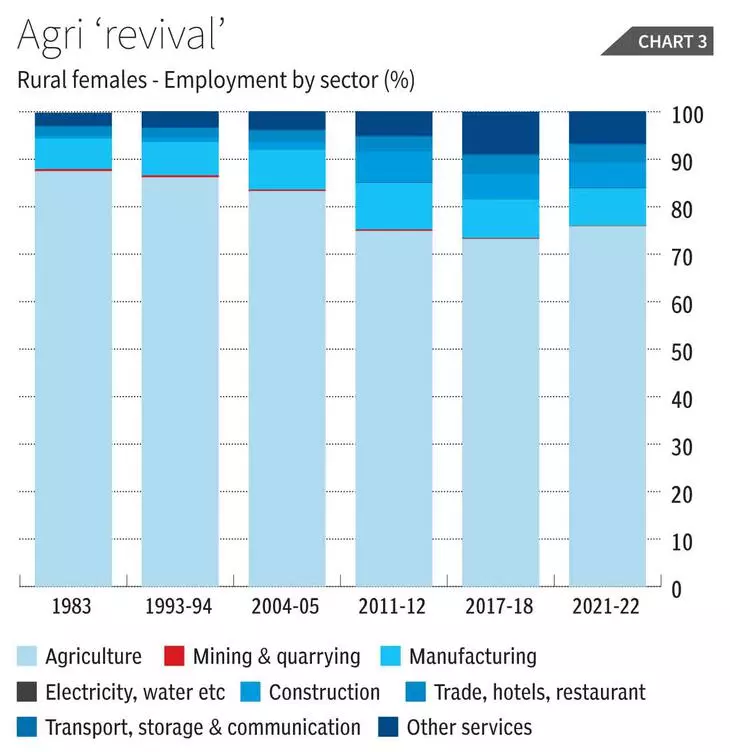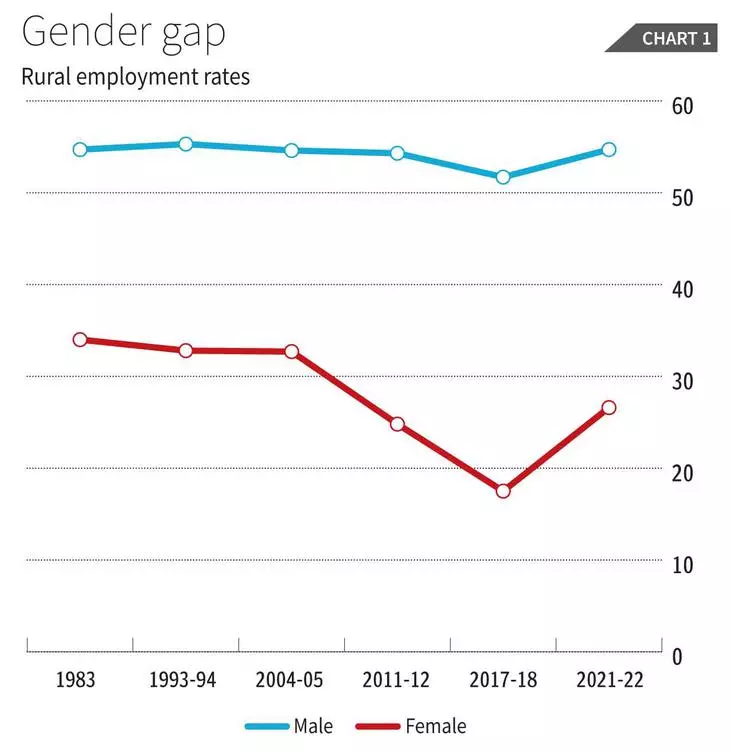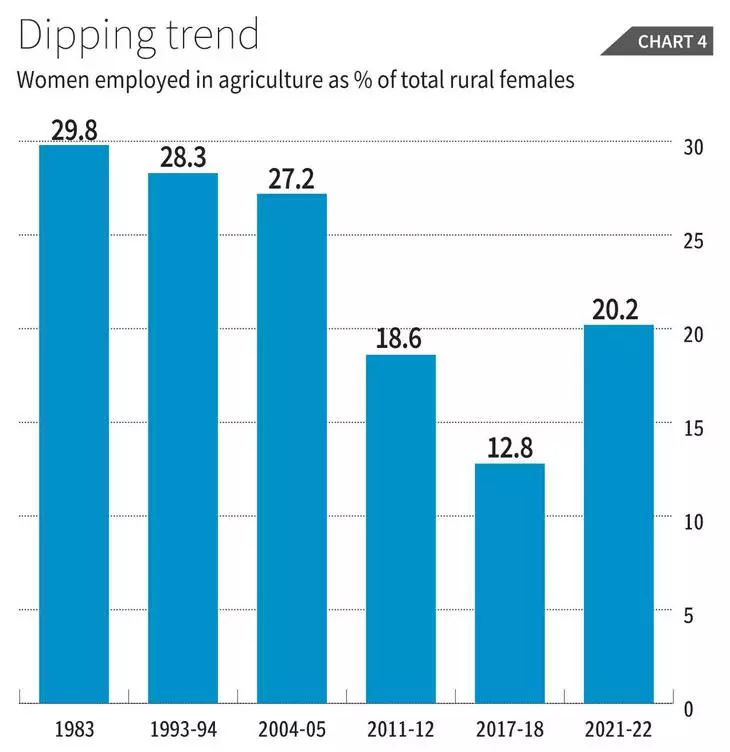Economy
Diversifying India’s Rural Economy
- 30 May 2023
- 15 min read
This editorial is based on Is India’s rural economy diversifying? which was published in The Hindu Business Line on 29/05/2023. It talks about the Data which shows that rural employment diversification could be reversing due to lack of opportunities beyond farming.
Prelims: NFHS-5, Women’s LFPR,The Deendayal Antyodaya Yojana-National Rural Livelihood Mission (DAY-NRLM),Mahatma Gandhi National Rural Employment Guarantee Scheme (MGNREGS), Deen Dayal Upadhyaya Grameen Kaushalya Yojana (DDU-GKY), NRHM (ASHA), Aganwadi (PM-POSHAN), Banking Correspondence (BC-Sakhi), Shyama Prasad Mukherji Rurban Mission.
Mains: Participation of rural women in paid and unpaid work, Diversification of employment in rural economy, need to bridge employment opportunity gap in rural area.
In Indian rural economy, the slow pace of employment diversification has created an unstable and unviable situation as workers remain crowded into agriculture even as that sector show significant declines in share of GDP.
Insufficient economic diversification, from low value added to higher value-added activities, has been one of the important failures of the Indian development trajectory.
What are Statistics about Employment in Rural India?
Most of the workforce remains trapped in low-value employment in agriculture and other primary activities, along with low-paying services unlike the successful late industrialisers like Japan, South Korea and more recently China.
- Rural Employment diversification in past two decades: It happens with declining work participation rates for both men and women. Chart 1 shows how employment rates for rural males are very low and have remained broadly stagnant over four decades.
- Employment for Women:
- Low employment With Unstable Trend: For rural females the employment is very low rate of only 34 per cent, it further collapsing to as low as 17.5 per cent in 2017-18. There was a slight recovery in 2021-22 to less than 27 per cent, well below the rate of four decades earlier.
- This severe fall in women’s recognised employment was responsible for the absolute decline in total employment over the period from 2011-12 to 2017-18.
- Chart 4 presents the share of women employed in agriculture as a proportion of the total rural female population. This declined continuously over the decades, reaching only 12.8 per cent in 2017-18. The subsequent increase to 20.2% in 2021-22 seems to be more of a distress move because even that remains well below the levels of earlier decades.
- This severe fall in women’s recognised employment was responsible for the absolute decline in total employment over the period from 2011-12 to 2017-18.
- Low employment With Unstable Trend: For rural females the employment is very low rate of only 34 per cent, it further collapsing to as low as 17.5 per cent in 2017-18. There was a slight recovery in 2021-22 to less than 27 per cent, well below the rate of four decades earlier.
- Unrecognized female labor: Female work participation rates do not capture all work, but only recognised employment, including self-employment. This excludes a very large amount of work performed in unpaid form by (mainly) women in the process of activities that ensure household consumption and survival.
- Unpaid work consists not just of unpaid care work within households, but also essential activities like fetching water and fuelwood, kitchen gardening, poultry raising etc.
- Female not only unpaid workers but unpaid helpers also: The significant proportion of recognised women workers (around one-third in rural areas) are described as “unpaid helpers in family enterprises” — typically farms.
Structure of employment for male workers:
- Employment in Agriculture: There have been changes in the structure of employment for male workers. Chart 2 provides a sense of the sectoral changes in employment for rural male workers. There is a continuous decline in the share of agriculture from 77.5 per cent in 1983 to 51 per cent in 2021-22.
- Employment in Construction: More than half of declining share of agriculture is explained by the rise of construction as a major employer, which accounted for 16.6 per cent of rural male employment by 2021-22.
- The share of manufacturing barely budged, remaining at 7-8 per cent, indicating the failure of rural industrialization to take off to any meaningful extent.
- Employment in Service Sector: Trade hotels and restaurants more than doubled their share of male employment, and transport services also increased. But a significant proportion of these also remain relatively low-paying activities.
Structure of employment for female workers:
- Much limited diversity in female employment: For rural females' diversification of employment was much less evident.
- Employment in Agriculture: The share of agriculture declined, but only from 87.5 per cent in 1983 to 73.2 per cent in 2017-18 — and then remarkably showed a renewed increase in 2021-22 to 75.9%.
- Most of the women declared themselves as self-employment works as an unpaid help in family farms, since wage employment (whether regular or casual) is less likely to be a “refuge” sector.
- Employment in Agriculture: The share of agriculture declined, but only from 87.5 per cent in 1983 to 73.2 per cent in 2017-18 — and then remarkably showed a renewed increase in 2021-22 to 75.9%.
- Employment in Manufacturing: Manufacturing employment provided work for 6.4 per cent of rural women in 1983, and this increased to 9.8 per cent in 2011-12. It declined once again, to account for only 7.9% of rural women recognised workers in 2021-22.
- Employment in Construction: Construction increased significantly but still accounted for only 5.3% of rural female employment.
- Employment in Service Sector: Other services, mainly community and personal services, also showed substantial increases (from 2.8 per cent in 1983 to 8.9 per cent in 2017-18) but then declined again for the most recent period, to 6.8 per cent.
- The recent “revival” in the share of agriculture in women’s employment reflects the decline of other activities in terms of viable employment opportunities.

- Women Employment as per NFHS-5: Around 75% of boys and men in the age group of 15-49 are currently employed, while only 25% of girls and women in the same age group have jobs.
- In the working age group of 15 to 49, about 32% women are employed. The shocker is that 15% of working women are not paid for their work.
What are Reasons for lack of Diversity in Rural Area?
- Agriculture-centric economy: Rural economy massively relies on agriculture (more than 50% of the population directly or indirectly depend upon agriculture), which is dependent on unpredictable monsoon and prone to droughts and floods. This leads to low and erratic income for farmers and agricultural workers.
- Due to factors like small landholdings, lack of modern techniques, and inadequate infrastructure, farmers often face low productivity and income instability.
- Lack of non-agricultural job opportunities: Lack of access to financial resources, such as credit, insurance and savings, limits the ability of rural people to invest in productive activities, cope with shocks and diversify their livelihoods.
- Industries and businesses tend to concentrate in urban areas, resulting in a lack of diverse economic activities in rural regions.
- Inadequate infrastructure: Lack of adequate infrastructure, such as roads, electricity, irrigation, telecommunications, housing, health and education, hampers the growth of non-farm sectors and reduces access to markets, services and opportunities.
- Limited access to education and skills training: Low levels of education and skills among rural people restrict their employability and mobility in the labour market. Many rural children drop out of school due to poverty, lack of sanitation facilities, early marriage or household work.
- The lack of educational and vocational opportunities hinders the development of new economic sectors.
- Social and cultural factors: Social inequalities based on caste, gender, religion or ethnicity also affect the economic opportunities and outcomes of rural people. Women, scheduled castes and tribes, minorities and other marginalized groups face discrimination, exclusion and violence that limit their economic potential.
- Limited access to credit and financial services: Rural communities often face difficulties in accessing credit and financial services. This makes it challenging for entrepreneurs and small businesses to start or expand their operations. The lack of financial support hampers the growth of diverse economic activities.
What have been done to diversify employment in Rural India?
- The Deendayal Antyodaya Yojana - National Rural Livelihood Mission (DAY-NRLM) aims to enable economically weak households to access gainful self-employment and skilled wage employment opportunities resulting in sustainable and diversified livelihood options for them. The cornerstone of the Mission is its ‘community-driven’ approach which has provided a huge platform in the form of community institutions for women empowerment.
- The Mission has mobilised a total of 8.7 crore women from poor and vulnerable communities into 81 lakh SHGs.
- Mahatma Gandhi National Rural Employment Guarantee Scheme (MGNREGS): The scheme is to provide guaranteed employment to unskilled workforce with secured employment to women.
- The work done under the scheme have a significant positive impact on agricultural productivity, production-related expenditure, and income per household, along with a negative association with migration and fall in indebtedness, especially from non-institutional sources.
- Deen Dayal Upadhyaya Grameen Kaushalya Yojana (DDU-GKY): Scheme provides Skills to the unskilled youth to have employment in the various non-Agri sectors.
- Women Empowerment: Women empowerment by employing them in various non-Agri sectors in rural area like NRHM (ASHA), Aganwadi (PM-POSHAN), Banking Correspondence (BC-Sakhi) etc.
- Rural Infrastructure: Under Pradhan Mantri Gram Sadak Yojana rural roads measuring 7,23,893 km have been created.
- Shyama Prasad Mukherji Rurban Mission: The scheme has been launched to develop a cluster of villages that preserve and nurture the essence of rural community life with focus on equity, and inclusiveness, without compromising with the facilities perceived to be essentially urban in nature, thus creating a cluster of urban villages.
What need to be Done?
Addressing these challenges requires a multi-faceted approach, including investments in infrastructure, education and skill development, access to credit and financial services, and the implementation of policies that promote diversification and inclusive growth in rural areas.
- Infrastructure development: Improve transportation, communication, and other basic infrastructure in rural areas to attract businesses and investment.
- Entrepreneurship support: Encourage entrepreneurship and provide support to rural entrepreneurs by bringing better implementation of schemes like PM-EGP (Prime Ministers Employment Generation Programme).
- Industry diversification: Promote the development of diverse industries (like Food Processing, Traditional goods & services, rural tourism, etc.) in rural areas to reduce dependence on a single sector (Agriculture). This can involve identifying and nurturing sectors that have growth potential and align with the local resources, such as agriculture, tourism, renewable energy, manufacturing, or technology.
- Skill development and education: Enhance access to quality education and skill development programs in rural areas by vocational training and internship in urban industries.
- Support for remote work and telecommuting: Invest in infrastructure and resources that enable remote work and telecommuting opportunities in rural areas. This can include improving internet connectivity, establishing co-working spaces, and promoting telecommuting initiatives with local businesses.
- Regional collaboration and partnerships: Encourage collaboration between rural areas, government agencies, private sector organizations, and nonprofit entities to pool resources, share knowledge, and develop joint initiatives aimed at attracting investment and creating employment opportunities.
- Community engagement and involvement: Encourage community engagement and involvement in the planning and decision-making processes related to rural development. This can help ensure that initiatives reflect the needs and aspirations of local residents and create a sense of ownership in the development process.
- Recognize Unpaid work of women: If such unpaid work is recognized (though it is not remunerated) more than 85 per cent of women in India are actively engaged in “economic” activity.
- Recognition of unpaid work brings choice among workers and the will to do work as per the demand and supply in the market and as per interest and capabilities and not as per compulsion. It further brings more formalization of the work force among females and their economic contribution in the nation building.
|
Drishti Mains Question: Indian agriculture is facing several issues ranging from the feminisation to lack of diversity of employment. Discuss the hurdles in the Indian agricultural economy and suggest measures in the context of given statement. |
UPSC Civil Services Examination, Previous Year Question (PYQ)
Mains
Q. Discuss the various economic and socio-cultural forces that are driving increasing feminization of agriculture in India. (2014)







